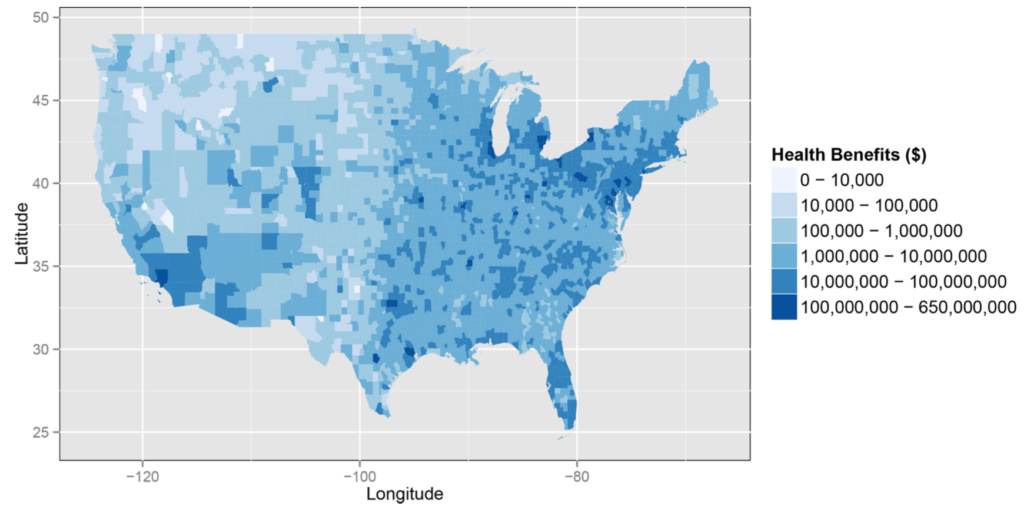In my last couple of blog posts, I’ve shown how deep reductions in CO2 emissions can have important co-benefits for public health by indirectly improving air quality, and examined how they should be considered when crafting climate-related policy.
My previous blog post emphasized just how crucial it is to establish monetary representations of the co-benefits described in this Harvard-Syracuse study on the health co-benefits of climate policies in the power sector. Marc Hafstead and Lawrence Goulder’s book Confronting the Climate Challenge does just this, by providing an insightful analysis of the monetized health co-benefits that a carbon tax could provide, demonstrating that the health co-benefits alone outweigh the welfare costs of the tax.
In a new paper, researchers have expanded on the Harvard-Syracuse study to monetize the co-benefits associated with the policy scenario that mimics the recently rolled-back U.S. Clean Power Plan. Importantly, their analysis includes the spatial and temporal distribution of the co-benefits, as well as the implications of a range of cost assumptions on delivering these benefits. The policy evaluated in the paper is implemented in 2020 and allows for a variety of compliance mechanisms, including demand-side energy efficiency improvements, power plants co-firing with low carbon-fuels and trading of emissions within and between states.
The national total monetized health co-benefits in the implementation year amount to $29 billion, while the net co-benefits using the central cost case is $12 billion. Most of this value is a result of avoided mortality due to decreases in PM2.5 and ozone and do not consider the potential direct climate benefits.
 Figure 1: Total annual co-benefits of moderately stringent, highly flexible carbon standards in 2020
Figure 1: Total annual co-benefits of moderately stringent, highly flexible carbon standards in 2020
The figure above demonstrates that all counties of the continental U.S. will receive annual co-benefits starting in 2020, the implementation year, with most counties gaining at least $1 million in annual co-benefits and a per capita analysis shows every individual gaining at least $100 of co-benefits per year. The regions that benefit the most from the policy are areas that presently rely on large amounts of coal and are characterized by poor air quality. It is noteworthy that the monetary gains of these co-benefits are realized relatively quickly, with some regions experiencing these benefits immediately. The authors point out that;
Under the central cost case the 2020 net co-benefits are positive in 10 out of 14 regions. For the lower cost case the net co-benefits are positive in 13 regions…even in the high cost case, there are positive net co-benefits in four out of 14 regions…Consequently even in the high cost case…co-benefits will exceed costs within six years for all regions except the Pacific Northwest.
Even accounting for the uncertainty related to cost recovery of the policy, the authors conclude that under the central cost assumption the value of health co-benefits will exceed costs in all but one of the regions in the U.S. by 2030 when the standards are fully implemented. The temporal aspect of their analysis adds another compelling argument to enact climate-related legislation, as most regions within the continental U.S. accrue monetary benefits within a year of implementation. The health co-benefits associated with climate mitigation policies are significantly larger than the compliance costs, widespread, and can occur nearly immediately. The spatial distribution and temporal immediacy of these benefits should motivate lawmakers to act accordingly in addressing the risks associated with climate change.